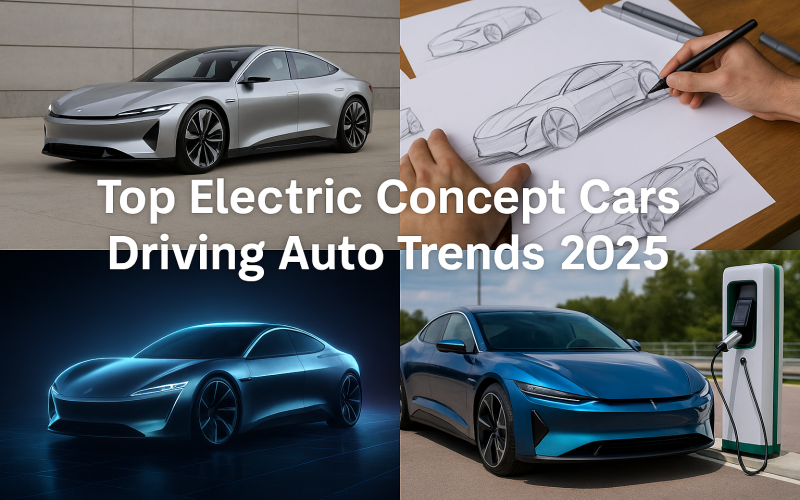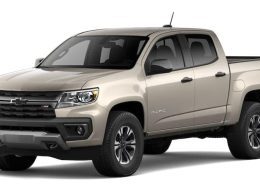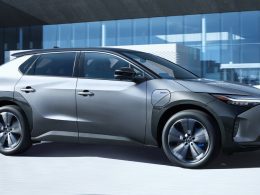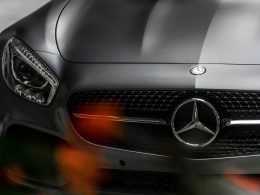A New Wave of Imagination
Electric vehicles are no longer niche experiments. In 2025 they anchor corporate strategies, from family hatchbacks to luxury saloons. Yet production models only hint at what is coming. To witness the boldest ideas—next-gen batteries, living-room cabins, recycled body panels—you need to study concept cars. Unveiled at Detroit, CES, and global mobility shows, these rolling prototypes reveal where range, charging, and digital-cockpit trends will head by decade’s end. They also spotlight fresh priorities: pieces built from ocean plastic, software that tailors acceleration to your heart rate, and price targets aimed below €25 000. The five concepts below encapsulate the most exciting electric directions of 2025.
What Counts as a “Concept” in 2025?
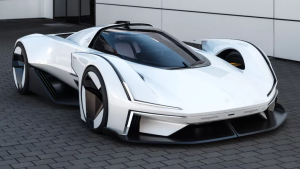
Car makers now show two main concept types. The visionary kind, like Chrysler’s Halcyon, dazzles with wild doors and translucent dashboards; it may never reach showrooms unchanged, but its tech roadmap does. The near-production kind, such as Volkswagen’s ID. 2all, wears real-world mirrors and legally sized bumpers—basically a camouflaged preview of an upcoming model. Both share one goal: generate buzz and gauge public reaction before heavy tooling begins.
2025’s Stand-Out Electric Concepts at a Glance
| Concept | Maker | Type | Claimed Range* | Key Innovation | |
|---|---|---|---|---|---|
| Vision Neue Klasse | BMW | Vision | 600 km | Sixth-gen eDrive, windshield AR | |
| ID. 2all | Volkswagen | Near-production | 450 km | Sub-€25 000 price, compact MEB | |
| FT-3e | Toyota | Vision | 500 km | Slim battery, energy-score doors | |
| Halcyon | Chrysler | Vision | 560 km | Solid-state pack, 3-in-1 seating | |
| Prologue Concept** | Honda | Near-production | 480 km | GM Ultium base, airy cabin |
*Manufacturer targets under WLTP cycle.
**Honda now markets “Prologue” as a 2025 production SUV, but the original prototype still guides design cues.
Vision Neue Klasse – BMW’s Digital Muscle Car
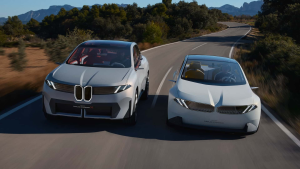
Design in Plain Words
The Neue Klasse looks both retro and sci-fi: shark-nose grille, square shoulders, and laser-thin headlights. Step inside and the dashboard melts away. Instead of traditional gauges, information projects across the full windshield, blending GPS turns with speed readouts. You glance ahead; data floats like holograms on the road.
Tech Highlights
BMW’s sixth-generation eDrive claims 30 percent more range and 30 percent faster charging versus today’s i4.
Why It Matters
Expect its battery chemistry—round cells with higher silicon anodes—to seep into mainstream sedans by 2027.
ID. 2all – Volkswagen’s Budget Game-Changer
Democratizing Range
Electric adoption stalls when price breaks budgets. Volkswagen targets this gap with the ID. 2all, promising €25 000 before incentives—roughly the cost of a petrol Golf. The small hatch still posts 450 km range and a 10-to-80 percent charge time of 20 minutes.
Interior Ideas
Physical buttons return—VW listened to complaints about touch sliders. A classic-style volume knob sits between air-con dials, proving that “tech” and tactile control can coexist.
Market Impact
Analysts believe cost parity with gasoline hovers near €25 000. If Volkswagen locks that tag, rivals must chase similar affordability, kicking off an EV price war that benefits every driver.
FT-3e – Toyota’s Tech Study on Wheels
Exterior Sensors as Storytellers
Along its doors, the FT-3e displays real-time battery state and cabin temperature on glowing side panels—a quick glance tells riders readiness before they climb in. Lightweight composites and aero-slick wheels lift efficiency.
Platform Versatility
Toyota built the FT-3e on a modular EV architecture scalable from compact crossovers to sports coupes. Developers can tweak wheelbase and battery height without re-engineering crash zones.
Looking Forward
Toyota has lagged in BEV launches, but the FT-3e signals a pivot. Watch for its slim-module battery pack—easier recycling, fewer rare earth metals—appearing first in Asian markets, then globally within three years.
Halcyon – Chrysler’s Rolling Lounge
Inside the Future
Chrysler tore up seating rules. In “Social” mode, the front chairs swivel 180°, meeting a rear bench that slides forward so four friends face each other around a retractable coffee table. “Zen” mode reclines all seats into a spa-style chaise, while smart glass dims the roof.
Battery Leap
Instead of today’s lithium-ion cells, the Halcyon prototypes a solid-state pack—safer, lighter, and good for 560 kilometres per charge. Combined with advanced wireless charging coils, the car tops up simply by parking over a floor pad.
Relevance to You
Even if swivel seats stay concept-only, Chrysler’s interior modularity themes—magnetic cup holders, rail-mounted speakers—could reach future Pacifica minivans, turning daily commutes into living-room extensions.
Honda Prologue Concept – From Sketch to Driveway
Partnership Power
Honda partnered with GM to borrow the Ultium battery platform, trimming R&D costs while focusing on cabin design. Result: a minimalist dash, slim A-pillars for clear sight lines, and Earth-tone fabrics made from recycled PET bottles.
Near-Term Reality
Unlike wilder visions, the Prologue hits U.S. dealers late 2025, which means its concept cues translate directly. Expect dual-motor AWD, fast DC charging, and over-the-air software zones that add or remove drive modes post-purchase.
Major Trends These Concepts Share
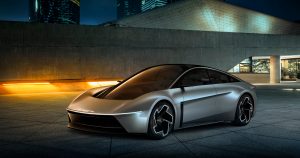
1. Smarter, Fewer Screens
BMW swaps full dashboards for windshield projection, Volkswagen revives physical knobs, and Toyota integrates subtle side-door readouts. Designers chase calm tech—data appears only when needed, freeing drivers from blinking clutter.
2. Battery Evolution
Solid-state cells, silicon-heavy anodes, and reduced cobalt chemistries headline spec sheets. Gains show up in real numbers: 30 percent better range or 20-minute top-ups. Environmental angles matter too; slim packs mean less mined material.
3. Circular Materials
From Chrysler’s plant-based seat foam to Toyota’s recycled polymers, concepts flaunt life-cycle thinking. The shift answers both regulation—EU battery passport rules—and customer desire to cut personal carbon prints.
4. Configurable Interiors
Electric skateboards flatten floors. Brands respond with sliding consoles, quick-swap seat rails, even magnetic accessories. The car interior morphs from fixed cabin to adaptive room, echoing tiny-home versatility.
5. Affordable Entry Points
Volkswagen isn’t alone. Rumors of €20 000 city EV concepts swirl.
Practical Tips for Future Buyers
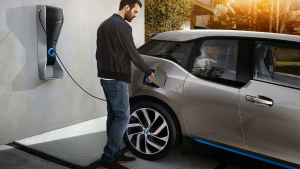
Monitor Concept Tech Transfer
Keep an eye on which features advance to “production confirmed” at later shows. For instance, BMW’s sixth-gen eDrive already appears in supplier timelines; solid-state packs remain three to five years out.
Evaluate Charging Ecosystems
Range sounds great, but 20-minute fast charges require 350 kW public plugs. Check your region’s rollout plans before banking on headline figures.
Factor Interior Flexibility
If you haul sports gear or pets, sliding rail seats could matter more than acceleration numbers. Concepts hint at modular accessories—order the rails now; buy camping pods later.
Watch Incentive Thresholds
Many tax credits cap eligibility by MSRP. An affordable concept hitting €25 000 might slot neatly under rebate ceilings, trimming thousands off final cost.
Conclusion
The electric concepts of 2025 preview a motoring future that is cleaner, smarter, and more people-centric. BMW’s windshield-as-screen, Volkswagen’s sub-€25 000 hatch, Toyota’s tech-study FT-3e, Chrysler’s living-room Halcyon, and Honda’s ready-for-road Prologue each push a different boundary—be it battery chemistry, cabin layout, or affordability. Together they map the decade’s journey: efficient cells, sustainable materials, adaptive interiors, and an ownership price within reach. Stay curious, follow production announcements, and you may soon park a slice of this visionary design in your own driveway.
Call to Action: Want monthly updates on concept-to-production breakthroughs? Subscribe to our free EV Trend Tracker and turn cutting-edge ideas into informed buying decisions.






